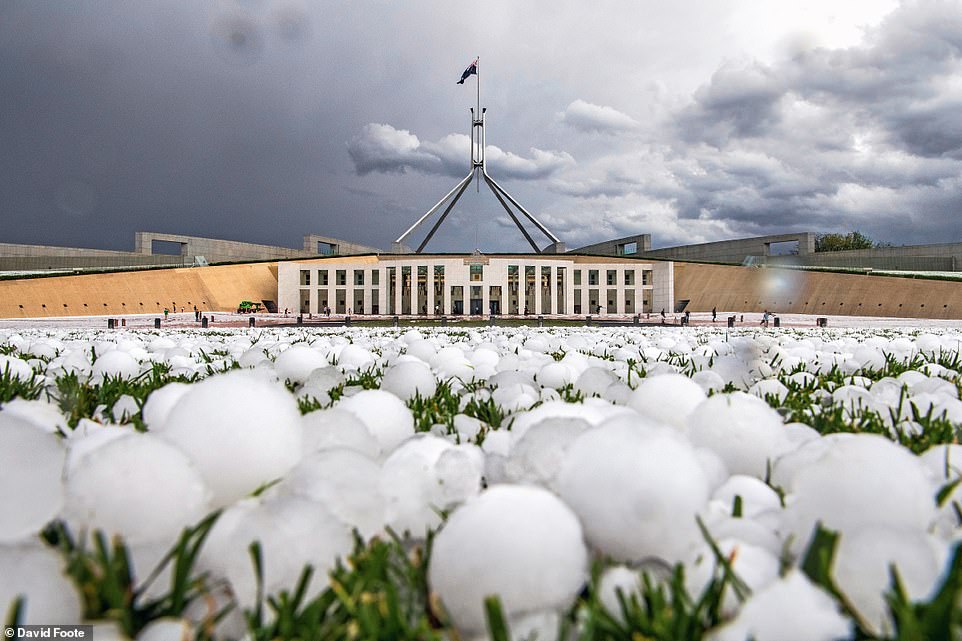[ad_1]
Australia has experienced some of the harshest weather conditions in 2020 from catastrophic bushfires, life-threatening storms and devastating droughts.
The Bureau of Meteorology called on the public to submit images they took of the weather events for their 2021 calendar.
The weather agency unveiled the 13 winning images from more than 1,400 entries on Wednesday.
One image featured ferocious lightning over Gulf St Vincent and Happy Valley Reservoir, Adelaide, South Australia as dark clouds brewed in the sky.
The incredible shot will be the cover photo for the month of April.
Another stunning image showed a mammatus cloud, which is a cellular pattern of pouches hanging underneath the base of a cloud, in southern New South Wales.
The Bureau’s Community Engagement Manager Brooke Leung said: “Australia experiences such a dynamic range of extreme weather events. The calendar is a great opportunity to share powerful weather-related images and teach Australian communities the science behind each photo.’

Cover: The image of clumps of hail stones outside of Australia’s Parliament House in the middle of bushfire season were taken by the building’s official photographer David Foote on January 20. The frozen rain clumps transformed the area into a winter wonderland, but the hail left a path of damage in its wake with fallen trees and smashed windows

January: The circular rainbow shot was taken at Lake Argyle, Kununurra, Western Australia, by Col Leonhardt – who captured the rare phenomenon once before in 2013 – on February 5, 2020. He has tried to capture the same image since but it is almost impossible without a helicopter, as from above ground you can see the light’s reflection in both directions

February: A looming, orange dust storm approaching Mildura, Victoria, before it covered the town in 2019 was captured by Robert Klarich and his drone. ‘I’ve never seen a dust storm cause total darkness like that, they sky was as black as night. And then 10 minutes later it was back to normal again,’ he said

March: This gorgeous image of lines of clouds, also known as cloud streets, was taken by Jeanette Millier in Papunya, NT. The sunlight is seen beautifully reflecting off of the clouds and into the dirt streets below. Scientists aren’t exactly sure how the phenomenon is createdÂ

April:Â One image, taken in 2014 by a self-proclaimed backyard storm chaser, featured ferocious lightning over Gulf St Vincent and Happy Valley Reservoir, Adelaide, South Australia as dark clouds brewed in the sky. The lightning bolts look as though they are connecting the sky to the ground

May: A gorgeous sunset over Berwick, Melbourne, in produced an amazing purple tinge in the sky. However, science teacher Mr Sandner was enamored by the wave-like clouds appearing over his home. ‘What I love about clouds is that they’re always different, you’re never going to see the exact same formation,’ he said

June: Another stunning image showed a circular layered clouds at ski fields Perisher in 2019. Photographer Philip Lark said: ‘Everyone was just calling it a UFO cloud. All my friends just wanted to keep skiing, and I was like, “no, look at this cloud – you’re not going to see this again!”‘

July:Â Helen Commens has lived on a cattle station for 20 years and has seen her fair share of drought. But when flood waters dominated the area in 2019 and began to fill riverbeds – creating a green moss perfect for cattle to dine on

August:Â Ivan Sajko has been photographing storms in Port Macquarie, NSW, since 2013 and he claims the February 2020 storm, which created dangerous waves and eerie storm clouds, is the biggest he has ever seen

September: Pamela Pauline describes living on the Mona Vale headland, in Sydney, as on par with living in a lighthouse. She captured this incredible image of a waterspout with thunderous rain around it in 2016. She recalls thinking it must have been terrifying for those on board the tiny sailboat

October: Michael Coombes wakes up early and climbs Mount Coot-tha every time fog is forecasted for the morning. This 2018 photograph shows Brisbane as the city begins to wake up for the day. He said: ‘The view you get from Mt Coot-tha is spectacular, especially when you get that fog that just kind of settles in, and rolls through the city as the sun rises’

November:Â Another stunning image, captured in 2019, showed a mammatus cloud, which is a cellular pattern of pouches hanging underneath the base of a cloud, in southern New South Wales. Mr Ellis’s father purchased the home in 1949, and it narrowly avoided being burned down during the devastating bushfire season

December: The aurora australis, the Southern Lights, can only be captured from a few places in the world – including Cassidys Bay in Tasmania. Robert Cassidy captured the incredible image – throwing off shades of blue, purple and green – on a freezing October morning in 2015
[ad_2]
Source link





